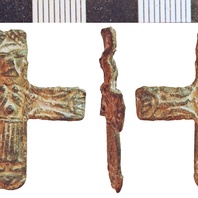
Item
Crucifix Pendant (NLM-AD60CD)
The settlement of Scandinavians in the Danelaw inevitably led in the end to their conversion to Christianity, though how this process happened and how long it took varied in different parts of the country and is still not fully understood. Finds from Scandinavian-settled areas, like this crucifix with a clear image of Christ on the cross, may well be evidence for this process.
Read More
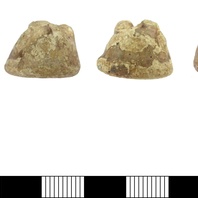
Viking Objects
Cast Lead-Alloy Gaming Piece (DENO-646EE0)
A complete cast lead-alloy early medieval gaming piece. This and similar pieces have also been interpreted as weights although the gaming piece interpretation is more secure. Pieces like this would have been used to play hnefatafl and/or Nine Men’s Morris, both of which are known to have been played in Scandinavia in the Viking Age.
Read More
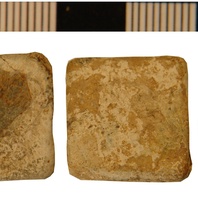
Viking Objects
Square Lead-Alloy Weight (NLM-941282)
Weights are an important form of evidence for Viking Age commerce and the use of standards across the different economic systems within which Vikings were integrated. Many of the weights discovered, particularly ones in Ireland and those of Arabic type, suggest that a standardized system of weights existed in some areas. These standard weights, alongside standard values of silver, are what allowed the bullion economy of Viking occupied areas to function. A bullion economy was a barter economy that relied on the exchange of set amounts of precious metal in various forms, such as arm-rings or coins, for tradable goods, such as food or textiles. Each merchant would have brought their own set of weights and scales to a transaction to make sure that the trade was conducted fairly.
Read More
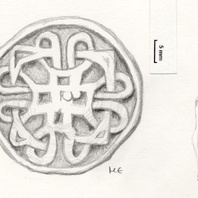
Viking Objects
Lead-Alloy Terslev Brooch (NLM-72D1C7)
This Borre-style brooch has been identified by Jane Kershaw as a Terslev Type V variant. Terslev style, where Scandinavian ring-chain patterns are the main decorative component, is a subcategory of the Borre style and takes its name from the silver hoard discovered in Terslev, Denmark. The decoration comprises a series of ring-knots related to the Borre ring-chain. The Terslev style occurs mainly on brooches and pendants, including both high-quality gold and silver jewellery as well as lower-end base metal items. The cast-base metal jewellery, such as those made of copper alloy, were intended to imitate the higher-end gold and silver jewellery, and often employed techniques such as gilding to achieve this. The Terslev designs that occur in England extend the repertoire by introducing new Scandinavian motifs hereto unrecorded in Scandinavia. For more information on Scandinavian jewellery in England check out our blog: Brooches, Pendants and Pins: Scandinavian Dress Accessories in England.
Read More
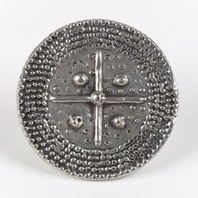
Viking Objects
Reproduction Lead Alloy Brooch
A reproduction of an early medieval, lead alloy brooch found at Barker Gate, Nottingham. Brooches were a typical part of female dress. Scandinavian brooches came in a variety of sizes and shapes which included disc, trefoil, lozenge, equal-armed, and oval shapes. The different brooch types served a variety of functions in Scandinavian female dress with oval brooches typically being used as shoulder clasps for apron-type dresses and the rest being used to secure an outer garment to an inner shift. Anglo-Saxon brooches do not match this diversity of form with large disc brooches being typical of ninth century dress styles with smaller ones becoming more popular in the later ninth and tenth centuries. However, since disc brooches were used by both Anglo-Saxon and Scandinavian women they are distinguished by their morphology. Scandinavian brooches were typically domed with a hollow back while Anglo-Saxon brooches were usually flat. Moreover, Anglo-Saxon brooches were worn singly without accompanying accessories.
Read More
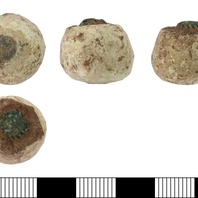
Viking Objects
Spherical Lead-Alloy Weight (DENO-650DB1)
This is a cast lead-alloy weight with a copper alloy Anglo-Saxon pin embedded in the centre. The base features a flattened copper alloy circular area that may be the worn remains of another embedded object. This piece demonstrates Anglo-Scandinavian reuse and repurposing of Anglo-Saxon metalwork. It has also been suggested that this item was a gaming piece although it does not resemble other known gaming pieces. Weights are an important form of evidence for Viking Age commerce and the use of standards across the different economic systems within which Vikings were integrated. Many of the weights discovered, particularly ones in Ireland and those of Arabic type, suggest that a standardized system of weights existed in some areas. These standard weights, alongside standard values of silver, are what allowed the bullion economy of Viking-occupied areas to function. A bullion economy was a barter economy that relied on the exchange of set amounts of precious metal in various forms, such as arm-rings or coins, for tradeable goods, such as food or textiles. Each merchant would have brought their own set of weights and scales to a transaction to make sure that the trade was conducted fairly.
Read More
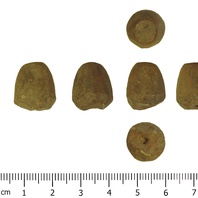
Viking Objects
Lead-Alloy Gaming Piece (DENO-7DABAC)
Lead gaming pieces like this one are a common find throughout the East Midlands, including the Torksey Viking camp. Gaming pieces would have been used to play games such as hnefatafl or Nine Men’s Morris, both of which are known to have been played by Scandinavians throughout the Viking diaspora.
Read More
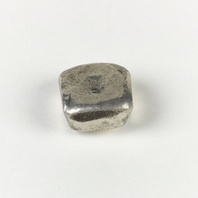
Viking Objects
Reproduction Square Weight
A square lead alloy weight based on one found in Nottinghamshire. It weighs 20g.
Read More
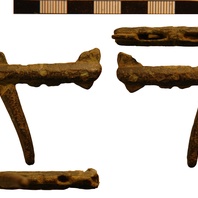
Viking Objects
Folding Arm Pivot Fragment (NLM-6A2893)
Scales were a common commerical tool and would have been an important part of any exchange whether using a monetary system or a bullion system, such as the one that existed in Viking-occupied areas of England.
Read More
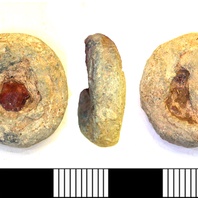
Viking Objects
Circular Weight (LEIC-5C4051)
This circular weight has a centrally placed orange stone chip inlaid into it. The distinction of weights by embedded objects or other embellishments in various media is a widely recognised feature of some early medieval weights. Weights are an important form of evidence for Viking Age commerce and the use of standards across the different economic systems within which Vikings were integrated. Many of the weights discovered, particularly ones in Ireland and those of Arabic type, suggest that a standardized system of weights existed in some areas. These standard weights, alongside standard values of silver, are what allowed the bullion economy of Viking occupied areas to function. A bullion economy was a barter economy that relied on the exchange of set amounts of precious metal in various forms, such as arm-rings or coins, for tradable goods, such as food or textiles. Each merchant would have brought their own set of weights and scales to a transaction to make sure that the trade was conducted fairly.
Read More
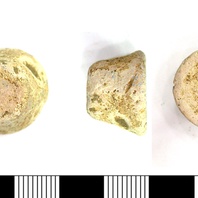
Viking Objects
Lead-Alloy Gaming Piece (LEIC-F39697)
This and similar pieces have also been interpreted as weights although the gaming-piece interpretation is more secure. Pieces like this would have been used to play hnefatafl and/or Nine Men’s Morris, both of which are known to have been played in Scandinavia in the Viking Age.
